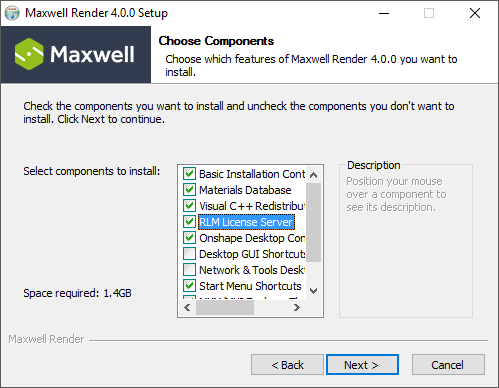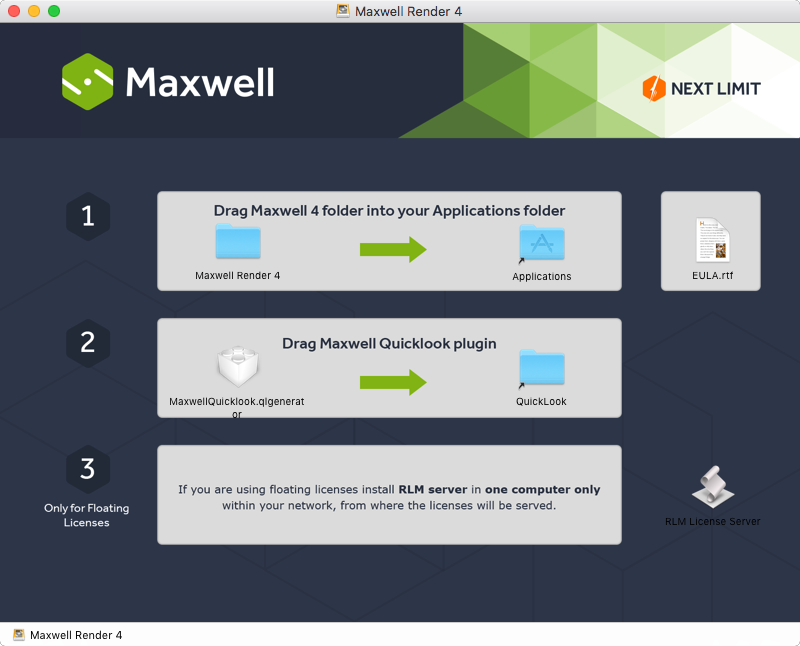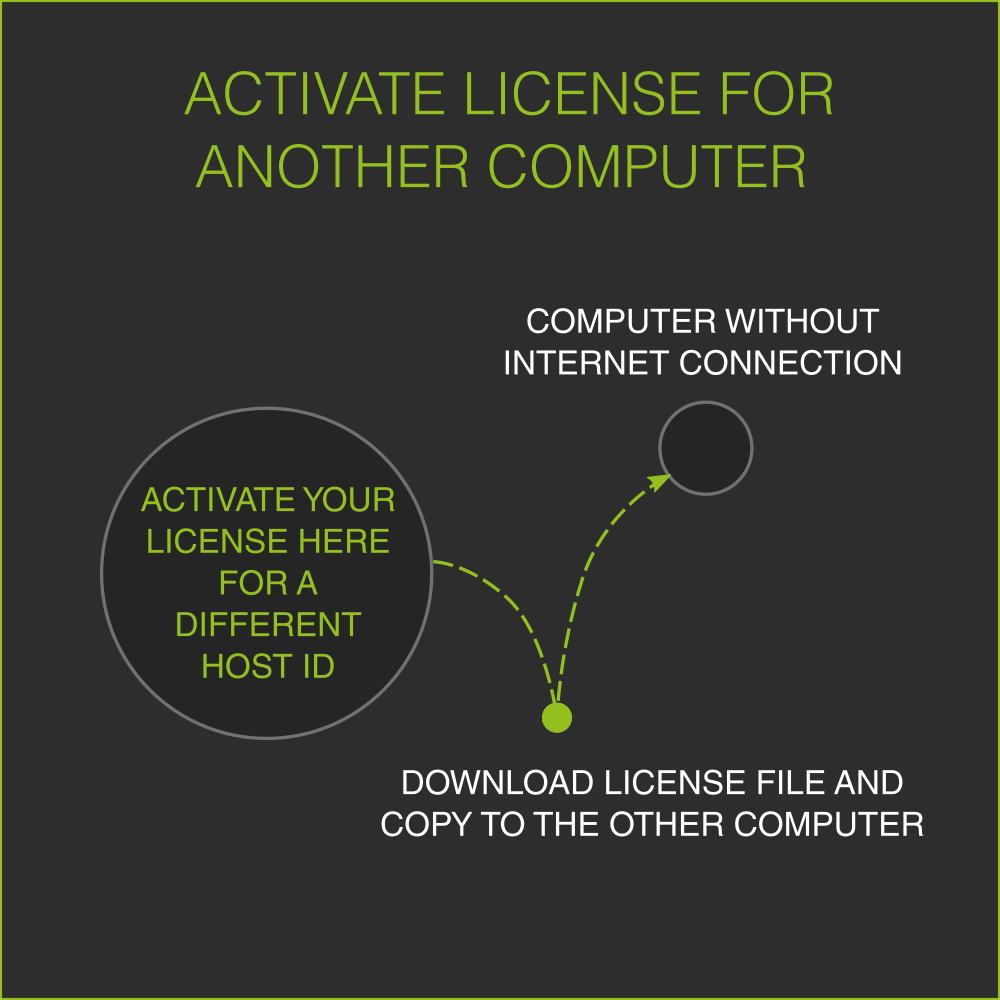Floating license activation
Before you begin
This image summarizes the concept of floating licenses.
When you use floating licenses, all of them are stored in one computer which runs the RLM License Server. The rest of the computers just connect to the computer which runs the RLM to ask for the license when required. The benefit of this method is that it is easier to license a big amount of computers and you can have Maxwell installed in more computers than licenses you have; the drawback is that the licenses stay with the License Server and if you move a computer out of your local network it won't get a license.
So the steps to install floating licenses are:
1.- Install the RLM (included in the applications' installer).
2.- Activate license keys (using the License Activator).
3.- Connect the rest of the computers to the RLM License Server (also through the License Activator).
If you are installing a V4.x update, you do not need to re-license Maxwell. It is only if you are upgrading from V1.x, V2.x or V3.x to V4.x that you need to re-license Maxwell because the license is different.
Step 1.- Install the RLM License Server
The RLM License Server is a small application that should come included in the installer of the products. You should only have one installed in your network and the license keys have to be activated on the computer that runs the RLM so they can be distributed among the rest of the computers.
In Windows and Linux it will be installed if you check the following box in the installer of your app:
In OSX you just have to double click the icon in the third step of the installer:
The plugins may have a different way of delivering the RLM license manager. Please check the particular installation guide of your plugin to learn about it.
Step 2.- Activate license keys
Once you have installed your application and the RLM License Server you can proceed to activate your licenses in the computer that is running the RLM. For that we use the License Activator. If Maxwell is unlicensed, it will come up when you open any application that needs a license to work, but you can also find it by opening Maxwell Render application (green icon without color touch) and going to Help menu > Activate License... or double clicking licenseactivator.exe in Maxwell installation folder.
Once the License Activator opens, please follow the instructions in this video:
This will store two .lic files in this computer; one will be the license file itself (maxwell_product.lic) and the other will just tell Maxwell where is the RLM server (maxwell_license.lic). They will be stored in the following folders:
Windows: C:\ProgramData\Next Limit\Maxwell\licenses
OSX: maxwell_product.lic: Users/Shared/NextLimit/rlm_nl/Licenses
maxwell_license.lic: Users/Home/Maxwell
Linux: $HOME/Maxwell
If the activation process has finished successfully you can now connect the rest of the computers to the RLM server so they get their licenses. If you get some error, please check Licensing Troubleshooting section and if that doesn't help, take some screenshots showing the error and contact the support team through the Customer Portal.
Step 3.- Connect the rest of the computers to the RLM License Server
Now you can connect the rest of the computers to the RLM in order to get their licenses from it. You don't have to activate the license again in the rest of the computers. We will use the License Activator for this too.
This process will generate a file called maxwell_license.lic in this computer that will point to the location of the RLM. It will include a simple line like this:
HOST name or IP address of the rlm computer ANY 5053
And it will be located in this folder:
Windows: C:\ProgramData\Next Limit\Maxwell\licenses
OSX: Users\Home\Maxwell
Linux: $HOME/Maxwell
If you have 4-5 computers that you have to connect to the RLM, using the License Activator can be comfortable, but beyond that, it might be better just to copy this file to the same folder in each computer. The file will be the same for all the machines in the same network.
After completing these steps successfully all your computers should be licensed.
Using a system environment variable to connect to the RLM server
It is possible to use an environment variable to tell Maxwell in which computer is the RLM located; it should look like this: nextlimit_LICENSE=port@host. For example, if you want a rendernode to point to a license manager that has the IP 192.168.0.19 using the port 5053 you have to set an environment variable which looks like this: nextlimit_LICENSE=5053@192.168.0.13
Additionally, you can make a node look for the license into two different computers, like this: nextlimit_LICENSE=5053@192.168.0.13;5053@192.168.0.35
This step is not working in my computer!
If after following this step Maxwell still shows unlicensed it might happen that the connection with the RLM is being blocked by a firewall in the computer running the license server. In this case you should add an exception to allow the RLM License Server through the firewall. You can find the RLM executable file in the following paths:
Windows: C:\Program Files\Next Limit\rlm
MacOS: Users/Shared/NextLimit/rlm_nl
Activate a license for a different computer
Sometimes the computer you want to use as RLM server is not connected to internet for security reasons. As we need an internet connection in order to generate the license file we will need to generate the license file in a different computer and then move the license file to the RLM computer.
The process will be something like this
As the activation process ties the license key with the machine host ID, we will need to know the host ID of the machine running the RLM server in advance.
The easiest way to know the host ID of a machine is opening Maxwell and going to Help menu > License Info... You will see the host ID in the first line of the box of text that comes up:
If you want to learn more ways to find the host ID, please take a look at this section, entry #7: Licensing Troubleshooting
Once we know the host ID it's easy to activate the license; just follow this video:
As mentioned in the video, after following this steps, you will get a .lic file downloaded which you should move to the other computer and save it in this folder:
Windows: C:\ProgramData\Next Limit\Maxwell\licenses
OSX: Users\Shared\NextLimit\rlm_nl\Licenses
Linux: $HOME/Maxwell
The computer running the RLM will also need a small file called maxwell_license.lic that tells Maxwell that the RLM server is running in locally in this computer. You can make it yourself in a text editor and rename it to maxwell_license.lic and it should include this line of text:
HOST localhost ANY 5053
Or you can download it from here: maxwell_license.zip
This one should be placed in this folder:
Windows: C:\ProgramData\Next Limit\Maxwell\licenses
OSX: Users\Home\Maxwell
Linux: $HOME/Maxwell
Then you should either restart your computer or issue a Reread/Restart command to the rlm server; please, check the related section to learn how to do it: RLM License Server.
After that, the RLM server should be licensed and serving licenses.
The most common licensing error messages
- Connection error - Usually means the license activator and/or Maxwell Render is blocked by a firewall and can't reach our servers.
- "License could not be validated" - Usually has the same cause as the above.
- "License could not be saved" - This means Maxwell doesn't have enough permissions on your computer to write the license file to disk. Start the install process again, making sure to right-click on the installed and chosen "Run as Administrator".
- "The license is in use" - This means you have already activated your key in two different computers and you are not allowed to activate it in an additional one. If you have to activate the license for another computer (because your computer broke or had to change the hardware) please fill the following form and send it to us: Change of license server or machine.pdf
If you still have problems, the first thing you should do is open Maxwell (not Maxwell Studio) and look in the Console panel for any licensing errors. Then go to the licensing troubleshooting page to see if the error message is listed there, and what the solution is.
If you are using Windows it may happen that you can't find the folders mentioned above. It is because that folder is hidden by default. If you want to make it visible you can click this option in Windows explorer:





